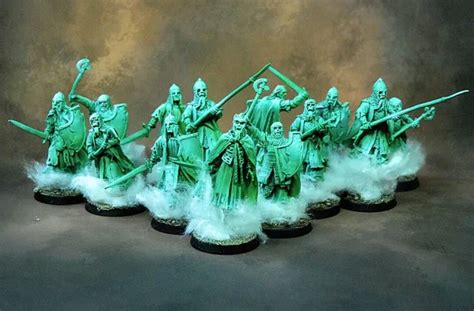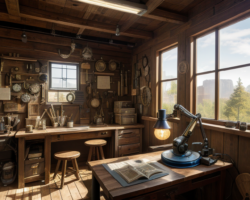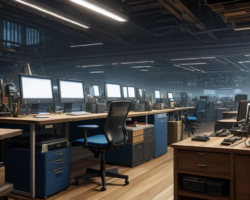Choosing the right miniature for your game
Choosing the right miniature for your game is an important step in creating an immersive and enjoyable gaming experience. Whether you are a beginner or an experienced gamer, the miniature you choose can greatly impact the overall look and feel of your game. There are several factors to consider when selecting a miniature, such as the game theme, size, and material.
When choosing a miniature for your game, it is important to consider the game theme. The miniature should match the setting and style of the game to enhance the storytelling element. If you are playing a fantasy game, for example, you may want to choose miniatures that depict mythical creatures, warriors, and wizards. On the other hand, if you are playing a sci-fi game, you may prefer miniatures that represent futuristic technology and alien species.
Size is another important factor to consider when choosing a miniature. Miniatures come in various sizes, ranging from tiny 6mm figures to larger 54mm models. The size of the miniature should be appropriate for the scale of your game and the level of detail you want to achieve. Smaller miniatures are often used for large-scale battles or games with a lot of units, while larger miniatures are generally used for display purposes or for games that focus on individual characters.
Material is also an essential consideration when choosing a miniature for your game. Miniatures can be made from a variety of materials, each with its own advantages and disadvantages. Plastic miniatures are commonly used for their affordability and ease of customization. Metal miniatures, on the other hand, are known for their durability and fine detail. Resin miniatures offer a good balance between detail and cost. It is important to consider your budget and the level of detail you want when deciding on the material of your miniature.
- Consider the game theme
- Choose the appropriate size
- Consider the material
| Game Theme | Size | Material |
|---|---|---|
| Fantasy | Small to medium | Plastic or metal |
| Sci-fi | Small to medium | Plastic or metal |
| Historical | Small to large | Plastic, metal, or resin |
Understanding the basics of miniature painting
Miniature painting is a popular hobby that allows individuals to bring their favorite characters and settings to life in intricate and detailed ways. Whether you are a seasoned painter or just starting out, it is important to understand the basics of miniature painting in order to achieve the best results. In this blog post, we will explore the essential techniques, tools, and materials that you need to know in order to embark on your miniature painting journey.
1. Choosing the right miniature for your game
Before diving into the painting process, it is crucial to select the right miniature for your game. Consider the scale, theme, and level of detail that you are looking for. Whether you prefer fantasy creatures, historical figures, or science fiction models, make sure to choose a miniature that resonates with your interests and fits the overall aesthetic of your game.
2. Preparing your miniature for painting
Once you have chosen your miniature, it is important to prepare it for painting. This involves removing any mold lines or imperfections using a hobby knife or file. Additionally, make sure to clean the miniature with soap and warm water to remove any oils or residues that may affect the adhesion of the paint. Priming the miniature with a suitable primer will create a smooth and even surface for the paint to adhere to.
3. Essential tools and materials for miniature painting
Having the right tools and materials is essential for achieving high-quality results in miniature painting. Some of the basic tools include brushes of different sizes and shapes, a palette for mixing colors, and a water cup for rinsing brushes. When it comes to materials, acrylic paints are commonly used for miniature painting due to their versatility and fast drying time. It is also useful to have a range of paint colors, as well as washes and drybrushing techniques to add depth and dimension to your miniatures.
By understanding these basics of miniature painting, you can lay a strong foundation for your painting journey. Whether you are a beginner or an experienced painter, mastering these techniques, tools, and materials will help you create stunning and visually appealing miniatures that truly stand out.
List of essential tools and materials:
| Tools | Materials |
|---|---|
| Brushes | Acrylic paints |
| Palette | Paint washes |
| Water cup | Primer |
| Hobby knife | Paint colors |
| File | Drybrushing materials |
Preparing your miniature for painting
Preparing your miniature for painting is an essential step in achieving stunning and professional-level results. Whether you are a beginner or an experienced miniature artist, taking the time to properly prepare your miniature will greatly enhance the final outcome of your painting. In this blog post, we will explore the key steps involved in preparing your miniature for painting.
First and foremost, it is crucial to clean your miniature thoroughly before starting the painting process. Miniatures are often coated with release agents, oils, or residue from the manufacturing process. To remove these contaminants, gently wash your miniature with warm soapy water and a soft brush. Rinse it thoroughly and allow it to dry completely before moving on to the next step.
After the miniature is clean and dry, the next step is to inspect it for any imperfections. Use a magnifying glass to carefully examine the surface for mold lines, flash, or other unwanted blemishes. These imperfections can detract from the overall appearance of your painted miniature, so it is essential to address them before proceeding.
- Use a hobby knife or a file to gently scrape or trim away any mold lines.
- Carefully remove any excess flash or sprue using appropriate modeling tools.
- If necessary, fill in any gaps or holes in the miniature with putty or a suitable filler.
Once you have addressed any imperfections, it is time to prime your miniature. Priming creates a smooth and uniform surface on which to apply your base coats and other layers of paint. It also helps the subsequent layers of paint adhere better to the miniature’s surface. Choose a primer color that complements your desired paint scheme. Black or white primers are commonly used, but other colors can also be used to achieve different effects.
Now that your miniature is properly prepared and primed, you are ready to start painting! By following these important steps, you have set a solid foundation for creating a beautifully painted miniature. Your attention to detail and preparation will ultimately make a significant difference in the final result. Happy painting!
Essential tools and materials for miniature painting
When it comes to miniature painting, having the right tools and materials is essential for achieving the best results. Whether you are a beginner or an experienced painter, having a well-stocked toolkit can make a significant difference in the outcome of your work. In this blog post, we will explore the essential tools and materials that every miniature painter should have.
1. Paints: The most obvious and crucial element in miniature painting is the paints themselves. It is recommended to invest in high-quality acrylic paints specifically designed for miniatures. These paints offer excellent coverage, vibrant colors, and durability. Additionally, consider having a variety of colors to achieve different effects and create eye-catching details on your miniatures.
2. Brushes: A set of high-quality brushes is another essential tool for miniature painting. Look for brushes with fine tips and different sizes to cater to various painting needs. Fine-detail brushes are perfect for painting intricate designs or adding highlights, while larger brushes are ideal for covering larger areas with a base coat. Take care of your brushes by cleaning and storing them properly to ensure longevity.
3. Palette: A palette is necessary for mixing and diluting paints. Opt for a palette made of a non-porous material like plastic or glass to make cleaning easier. Having a palette with wells or separate sections enables you to keep colors separate and organized, allowing for efficient paint mixing and blending.
4. Primer: Primer is a crucial step in miniature painting as it provides a smooth base for paint to adhere to, improves paint adhesion, and helps prevent chipping or flaking. Choose a primer specifically designed for miniatures and consider using a color that complements your intended paint scheme.
5. Files and Sandpaper: Files and sandpaper are essential for preparing miniatures before painting. They help remove mold lines, burrs, and imperfections on the surface of the miniature, ensuring a clean and smooth canvas for your painting. Use different grits of sandpaper to achieve the desired level of smoothness.
6. Sealant: Once you have completed your miniature painting, it’s essential to protect your work and preserve its quality. A sealant provides a protective layer, preventing the paint from chipping or getting damaged due to handling or environmental factors. Make sure to choose a sealant specifically formulated for miniatures and follow the manufacturer’s instructions when applying it.
| Tool/Material | Description |
|---|---|
| Paints | High-quality acrylic paints designed for miniatures |
| Brushes | Set of fine-detail brushes in different sizes |
| Palette | Non-porous palette for paint mixing and blending |
| Primer | Primer specifically designed for miniatures |
| Files and Sandpaper | Tools for preparing the miniature’s surface |
| Sealant | Protective layer for preserving the painted miniature |
These are just a few of the essential tools and materials for successful miniature painting. Remember, investing in high-quality supplies will make a significant difference in the quality and longevity of your work. So, equip yourself with the right tools and materials, and let your creativity shine through your beautifully painted miniatures!
Mastering different painting techniques for miniatures
When it comes to painting miniatures, there are a variety of techniques that can help elevate your skills and bring your models to life. Whether you are new to the hobby or have been painting for a while, mastering different painting techniques can take your miniatures to the next level. In this blog post, we will explore some of the key techniques that can help you enhance the detail, depth, and overall quality of your painted miniatures.
One of the fundamental painting techniques for miniatures is base coating. This is the process of applying a base layer of paint to your model to create a foundation for additional layers of color. Base coating provides a solid starting point and helps the subsequent layers of paint adhere better to the miniature surface. It is important to apply thin and even coats of paint during this stage to prevent the loss of intricate details.
Another important technique to master is shading and highlighting. Shading involves adding darker tones to the recessed areas of your miniature to create depth and definition. This can be achieved through various methods such as washes, glazes, or dry brushing. Highlighting, on the other hand, involves applying lighter tones to the raised areas of the model to give it a more realistic and three-dimensional appearance. By combining shading and highlighting techniques, you can bring out the details of your miniature and make it visually striking.
Adding intricate details and highlights to your miniatures
When it comes to miniature painting, adding intricate details and highlights is what truly brings your miniature to life. These small touches can make a significant difference in the overall appearance of your model, making it stand out on the gaming table or display shelf. In this blog post, we will delve into the art of adding intricate details and highlights to your miniatures, showcasing some techniques and tips that will help take your painting skills to the next level.
One of the key aspects of adding intricate details to your miniatures is having the right tools and materials at your disposal. A fine-tipped brush is essential for achieving precise lines and intricate patterns. Additionally, using a magnifying glass or a headset magnifier can greatly assist in working on those tiny details, ensuring that you can see and paint with precision.
Highlighting is another crucial technique to enhance the visual appeal of your miniatures. The key to achieving effective highlights is understanding light and how it interacts with different surfaces. Before you begin painting, take some time to study how light falls on objects in real life. This observation will help you determine where to place highlights on your miniature.
- Start by applying a base coat to your miniature, using a slightly lighter shade than your desired highlight color.
- Next, using an even lighter shade, carefully paint the raised areas of the model, such as the edges or sharp curves, where the light would naturally hit.
- To create a smooth transition from the base color to the highlight color, you can use a technique called “blending.” This involves gently blending the two colors together, creating a gradual shift in tone.
Adding intricate details and highlights to your miniatures may seem challenging at first, but with practice and patience, you can achieve stunning results. Remember to take your time, work in thin layers, and always test your techniques on a spare piece or practice model before applying them to your main project. Finally, don’t be afraid to experiment and develop your own unique style. Miniature painting is an art form that allows for endless creativity and personal expression.
| Benefits of adding intricate details and highlights: |
|---|
| Enhanced realism: Adding intricate details and highlights can make your miniatures look more realistic and visually appealing. |
| Increased visual interest: The added details and highlights draw the viewer’s attention, making your miniature stand out among others. |
| Showcasing skill: Mastering the art of adding intricate details and highlights demonstrates your painting skills and dedication to the hobby. |
Protecting and preserving your painted miniatures
As a miniature painting enthusiast, you have invested time and effort into creating beautiful and detailed works of art on your miniatures. It would be disheartening to see your hard work get damaged or fade away over time. That’s why protecting and preserving your painted miniatures is crucial to ensure their longevity and visual appeal. In this blog post, we will explore some essential techniques and products that will help you safeguard your miniature masterpieces.
1. Proper Storage:
One of the fundamental ways to protect your painted miniatures is by storing them properly. Keeping them in a suitable container or display case will shield them from dust, moisture, and accidental damage. Consider using a dedicated miniature storage case with foam inserts to ensure each figurine has its own compartment and is firmly held in place.
2. Varnishing:
An effective way to preserve your painted miniatures is by applying a coat of varnish. Varnish acts as a protective barrier, shielding the paint job from scratches, fading, and environmental factors. Use a brush or airbrush to evenly coat the miniatures with a matte or satin varnish. This will not only provide protection but also enhance the overall appearance by reducing unwanted shine.
3. Handling and Display:
When handling your painted miniatures, it is essential to be mindful of their delicacy. Avoid touching the painted surfaces directly as the oils from your skin can cause damage over time. Instead, hold them by the base or use gloves if necessary. Additionally, be careful when displaying your miniatures. Keep them away from direct sunlight as it can cause paint fading and create uneven colors.
4. Transportation:
If you often take your painted miniatures to gaming events or painting workshops, it is vital to protect them during transportation. Use a dedicated carrying case specifically designed for miniatures to prevent any accidental bumps or jostling that can damage the paint job. Additionally, consider using foam inserts or bubble wrap to provide cushioning and further safeguard your miniatures.
Conclusion:
Protecting and preserving your painted miniatures is essential to maintain their quality and value over time. By following these techniques and utilizing appropriate storage solutions, varnishes, and careful handling, you can ensure that your miniatures remain in pristine condition for years to come. Don’t let your hard work go to waste – make the necessary efforts to protect and preserve your prized miniature creations!
Frequently Asked Questions
Question 1: How do I choose the right miniature for my game?
When choosing a miniature for your game, consider factors such as its size, material, and compatibility with your game theme and mechanics. Research and compare different options before making a decision.
Question 2: What are the basics of miniature painting?
The basics of miniature painting include priming the miniature, building up layers of paint, and applying a protective sealant. It is also important to have a good understanding of color theory and brush techniques.
Question 3: How do I prepare my miniature for painting?
To prepare your miniature for painting, remove any mold lines or flash using tools like a hobby knife or files. Clean the miniature to remove any dirt or grease, and apply a primer to help the paint adhere better to the surface.
Question 4: What are the essential tools and materials for miniature painting?
Essential tools and materials for miniature painting include brushes of different sizes and shapes, paints in various colors, a palette for mixing, a water container, a magnifying glass, and a good lighting setup.
Question 5: How can I master different painting techniques for miniatures?
Mastery of different painting techniques for miniatures comes with practice and experimentation. Take the time to learn techniques such as dry brushing, washes, layering, and blending, and apply them to your miniatures to enhance their details and depth.
Question 6: How can I add intricate details and highlights to my miniatures?
To add intricate details and highlights to your miniatures, use a fine brush and thin paint to carefully pick out small features and edges. You can also use techniques like edge highlighting or glazing to create highlights and shadows for a more realistic effect.
Question 7: How can I protect and preserve my painted miniatures?
To protect and preserve your painted miniatures, consider applying a clear varnish or sealant after painting to prevent the paint from chipping or rubbing off. Additionally, handle them with care and store them in a safe location away from excessive heat or humidity.





